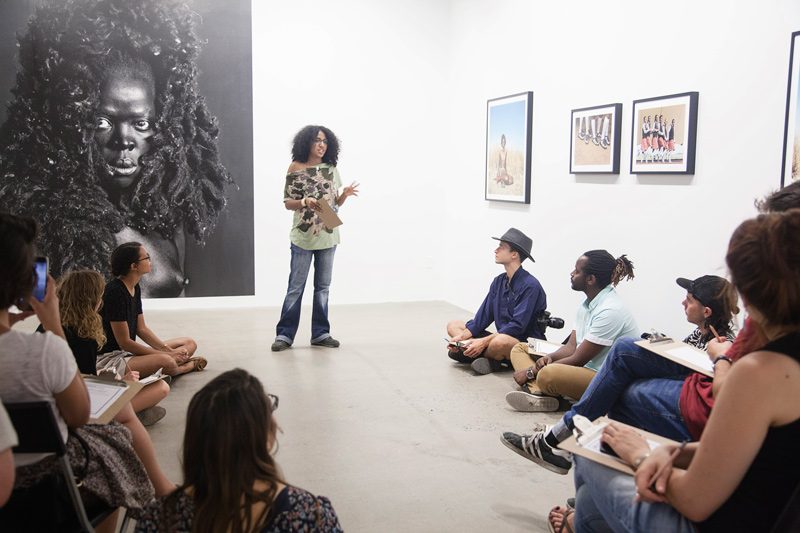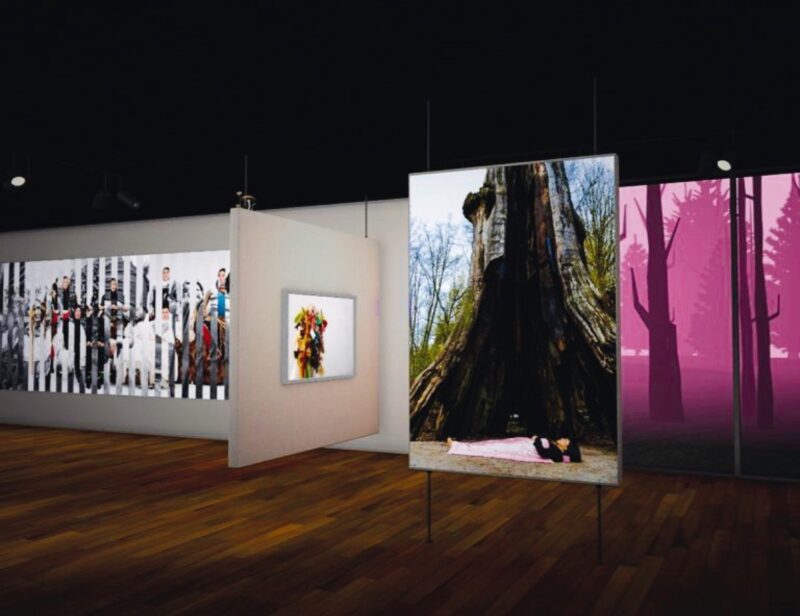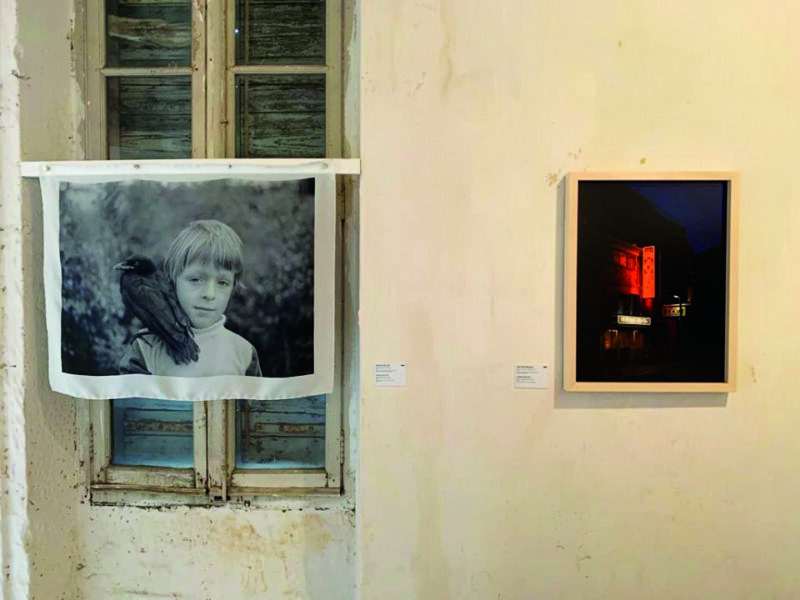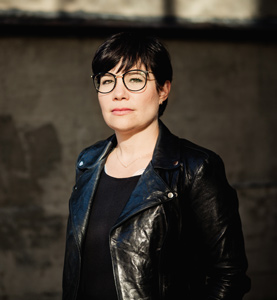An interview by Jacques Doyon
Audrey Genois has been the executive director of MOMENTA | Biennale de l’image (formerly Le Mois de la Photo à Montréal) since 2016. She was assistant curator at the Galerie de l’UQAM from 2002 to 2016. Over fifteen years, she organized more than sixty exhibitions and ten national and international touring exhibitions, edited and coordinated forty publications on contemporary art, and managed the UQAM art collection. Among her curatorial projects have been the exhibitions Guillaume Simoneau. Murder (Les Rencontres d’Arles), Expansion. Les 40 ans de l’UQAM (with Louise Déry), Vidéozoom. L’entre-images (presented in twelve venues in Canada and abroad, with the curatorial collective La Fabrique d’expositions), and Motion (in collaboration avec HEAD–Genève and La Fabrique d’expositions). She was associate curator for the exhibition David Altmejd: The Index, presented in the Canadian pavilion at the Venice Biennale in 2007. For the 2019 edition of MOMENTA, she was a member of the curatorial team with María Wills Londoño (guest curator) and Maude Johnson.
JD: This year’s biennale will be the second since the name change and repositioning of the organization in 2017. Can you remind us of what motivated you to proceed with this repositioning after you became executive director in 2016?
AG: I wouldn’t say that the biennale is being repositioned. It’s more a strategic reflection to contextualize the developments planned for the organization and, above all, to think about how we can raise the biennale’s visibility on the local, national, and international levels. We want to maintain continuity while trying new things to spread awareness of our activities and multiplying collaborations. It is important to mention that Le Mois de la Photo à Montréal (MPM) and MOMENTA should not be compared or contrasted, as it is all one and the same organization. This organization is thirty years old, so I think it’s healthy to ask ourselves questions about its future and the next chapters in its history.
The name change was aimed at giving a more accurate idea of what MPM had become over the years. MPM was perceived as a festival by the public, the art world, and the international community. Every time I talked about MPM, I had to specify that we weren’t a festival but a biennale. Also, visitors didn’t understand when they found that an edition was presenting more videos than photographs. In the 1980s, it was important to highlight the contribution of photography to contemporary art, but today we’re no longer concerned so much with divisions by discipline in the visual arts, and artists define themselves less and less according to a specific medium. In short, the name change was aimed at conveying the organization’s mandate more clearly so that we can more effectively communicate what we are and position ourselves within the network of biennales. In fact, we haven’t been the only organization called Mois de la Photo to change its name in order to keep up with the times; others did so before us and some are currently in the process of changing.
JD: How have these objectives been materialized and how have they evolved since the first MOMENTA biennale was held, in 2017?
AG: Following the 2017 edition of MOMENTA, we wrote a five-year strategic plan. This process of analysis and reflection, which was supervised and framed by kabana – a strategic finance and marketing consultancy – led us to update MOMENTA’s mission and mandate, which are now much more focused on the public and on the role that we want to have in society. We’ve updated the way in which we define our aspirations and actions. Our actions and choices are now guided by the objective of having a sensitive and sensible impact on the world through the image, which constitutes the essence of our mission.
Notably, MOMENTA’s program now comprises two components that are core to our mission: 1) the dissemination of contemporary art through our exhibitions, and 2) accessibility of contemporary art to a greater number of people through an engaging and innovative educational program, which we are calling MOMENTA Creative. This year, we’re also working with a communications and press relations agency, bicom, which has advised us on integration of new practices and is steering our implementation of new digital and marketing strategies.
For its thirtieth birthday, MOMENTA has given itself the gift of inspiring and enthusiastic people to guide it in its desire to do better, to experiment, and to be daring. My answers to the questions below convey how our new initiatives are being brought to life. They reflect the mission and the strategic objectives that we have set for MOMENTA: to increase the impact of art and to have MOMENTA’s actions speak to and be spoken about by more people and beyond the borders of Quebec and Canada.
JD: This year, the event’s exhibitions seem to have a clear sense of continuity, but you’re also innovating by contributing to Les Rencontres photographiques d’Arles with two exhibitions by Quebec artists.
AG: The importance of promoting Quebec artistic engagement internationally and developing links between the Montreal art scene and various art platforms abroad is in the organization’s DNA. However, instead of envisaging the promotion of Canadian artists solely within our own event, we hope to raise the visibility of artists and MOMENTA by initiating projects abroad or partnering with other events.
This year, we’re presenting two solo exhibitions in the official program of Les Rencontres d’Arles. This is an extraordinary showcase for Quebec artists and for our organization. We also have a partnership with the Paris exhibition platform LE BAL for an exhibition at OPTICA in Montreal. In 2020, we’ll be presenting projects in Scotland and France. The addition of this programming outside of the biennale makes it possible to intensify the establishment of our art community outside of Quebec. In coming years, one of MOMENTA’s objectives will be to develop new initiatives with partners in different locations in order to heighten the organization’s presence in the international art ecosystem and increase the visibility of Canadian artists.
JD: In your push to encourage involvement by the public and increase the biennale’s impact, you’re placing great emphasis on developing an educational component, and the activities are organized in collaboration with organizations from different areas. What is the scope of these activities? What new initiatives will we see?
AG: Core to our mission is to make the public aware of the societal issues that we address through contemporary art. MOMENTA Creative was set up in 2017 to provide a better structure for this aspect of our mission. MOMENTA has enhanced and refined its educational activities in order to reach a broader demographic and cultural mix. As a complement to the exhibitions, we’re developing a mediation program for audiences of all types, in a spirit of inclusion and accessibility to art. MOMENTA Creative is composed of a number of educational activities in which participants will learn about the artworks displayed and the social issues that they address, from didactic and creative perspectives. The activities are developed with the assistance of partner organizations and focus on social cohesion and teaching through the image. Among these non-profit organizations are Exeko (which works on social inclusion through creativity), the Fondation filles d’action (which favours the creation of spaces specific to girls and young women), and Brila (which develops activities linking philosophy and creativity). Working with them enhances the legitimacy and relevance of our initiatives and adds to innovation in our educational approach. It’s essential for MOMENTA to partner with organizations with specialized vocations to create activities that are relevant and adapted to their needs and those of their clienteles. They’re involved from the start with conceptualization of mediation activities. This type of collaborative work is extremely enriching. I should also mention that some mediation workshops take place in collaboration with artists. This is the case for Raphaëlle de Groot and Jamie Ross, each of whom will help to design a workshop for us. MOMENTA Creative will offer a total of ten workshops free of charge to varied and specific audiences of all ages, addressing subjects such as the environmental crisis, the discovery of Innu culture, and the Queer community in North America.
Our mandate also includes the desire to contribute to cultural and social innovation through our mediation activities. I’m thinking here, among other things, of the educational video game on Quebec photography that we’ve produced for children nine to twelve years of age and offered in art classes in Quebec schools. The game, available in French and English versions, is accessible online free of charge. MOMENTA hopes in this way to help to provide high-quality content for young audiences so that a greater number of children will have access to contemporary art and to works by Quebec artists. By developing a more innovative and inclusive MOMENTA, we hope to inspire our community and have a positive impact on our society. A second video game for a younger audience, kids aged six to nine, will be launched in late 2020.
In 2017, attendance at educational activities skyrocketed by 230%. The results for this year’s biennale will be counted, of course, by the number of visitors, but especially by the accessibility of our program and by the quality of encounters and exchanges that convey real inclusion of and cultural participation by citizens – the aim of all of our efforts with MOMENTA. As we like to say, MOMENTA is an effervescence of encounters and exchanges that transform our comprehension of the world one artwork at a time.
JD: You have also taken on the objective of increasing and energizing collaborations with the art scene. Here too, MPM, in its time, had initiated such collaborations by gathering the programming in certain venues around an event that reached a broad pubic. How is MOMENTA continuing and further developing this type of activity?
AG: From the beginning, MPM played a crucial role in the local ecology of the visual-arts scene by bringing a multitude of partners together around the organization. The fact is, without these partnerships we couldn’t exist. They have been the basis, the foundation of the organization for thirty years. MOMENTA is continuing down this road by acting as link and catalyst in the contemporary art milieu. We work closely with our exhibition partners to produce a common project. The exhibition projects for each venue have been developed in close collaboration in order to define projects that would take each venue’s artistic orientations into account. The coherence of the biennale program also means that each party (the venue, the artist, and us) feels that its expectations have been met and the best conditions have been created. The biennale couldn’t exist without our incredibly synergistic relationships with our partners – more and more of them each year. This makes it possible to engage in discussion and establish real connections. This year, we are deploying collaborations outside of Montreal by working with the Musée d’art de Joliette, which will present an exhibition from Les Rencontres d’Arles. One of the main reasons that I took the position of director was in fact to expand the family around MOMENTA. I see this spirit of camaraderie as essential in all relationships that I initiate or develop.
MOMENTA is also opening up to other collaborations with the creation of satellite programming, which includes twelve projects this year, and by associating with other events – for instance, the Foire Papier, the International Festival of Films on Art, the Montreal International Documentary Festival, and the Festival du nouveau cinema – to feature artists in our program. And we are continuing to develop partnerships in the context of MOMENTA Creative. MOMENTA wants to have a presence in the art landscape not just once every two years but continuously, through a multitude of partnerships that enable us to accomplish our mission with greater visibility and relevance. Translated by Käthe Roth
Jacques Doyon is editor-in-chief and director of Ciel variable.
[ Complete issue, in print and digital version, available here: Ciel variable 113 – TRANS-IDENTITIES ]
[ Individual article in digital version available here: CV113 – Audrey Genois — Jacques Doyon ]




